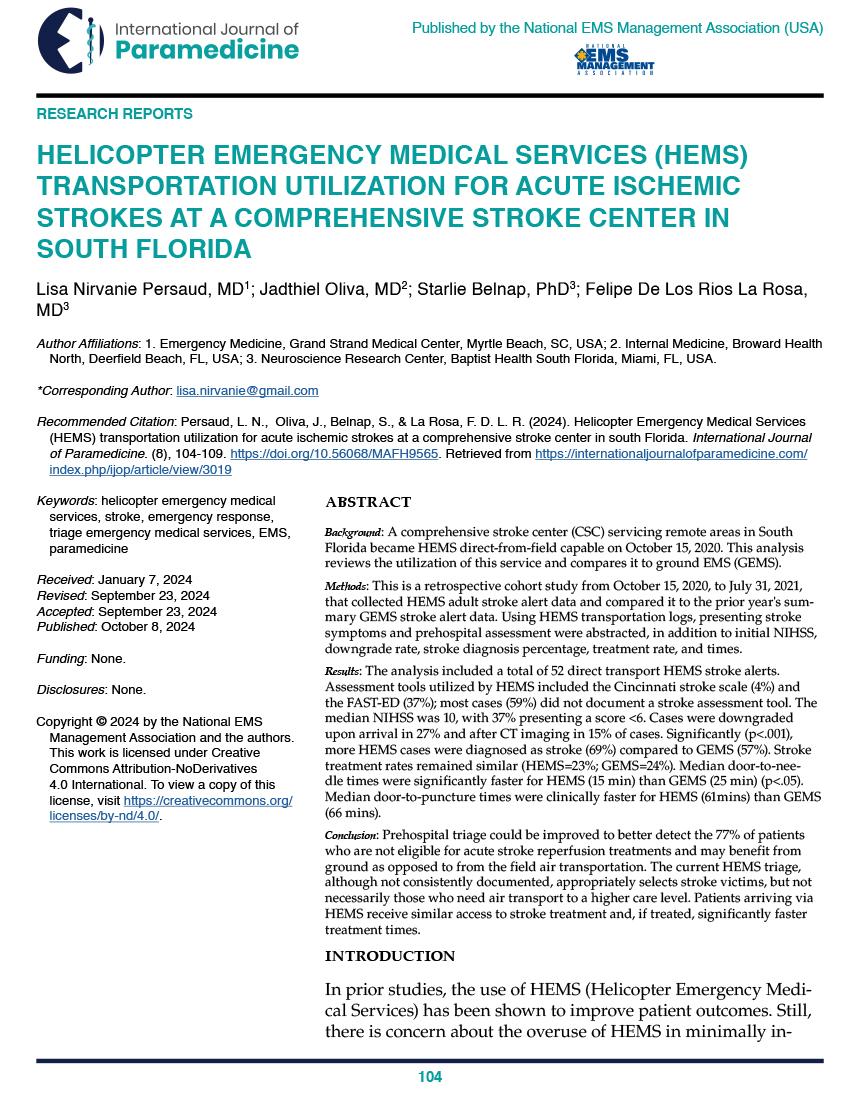Helicopter Emergency Medical Services (HEMS) Transportation Utilization for Acute Ischemic Strokes at a Community-Based Hospital in South Florida
Main Article Content
Abstract
Background: A comprehensive stroke center (CSC) servicing remote areas in South Florida became HEMS direct-from-field capable on October 15, 2020. This analysis reviews the utilization of this service and compares it to ground EMS (GEMS).
Methods: This is a retrospective cohort study from October 15, 2020, to July 31, 2021, that collected HEMS adult stroke alert data and compared it to the prior year's summary GEMS stroke alert data. Using HEMS transportation logs, presenting stroke symptoms and prehospital assessment were abstracted, in addition to initial NIHSS, downgrade rate, stroke diagnosis percentage, treatment rate, and times.
Results: The analysis included a total of 52 direct transport HEMS stroke alerts. Assessment tools utilized by HEMS included the Cincinnati stroke scale (4%) and the FAST-ED (37%); most cases (59%) did not document a stroke assessment tool. The median NIHSS was 10, with 37% presenting a score <6. Cases were downgraded upon arrival in 27% and after CT imaging in 15% of cases. Significantly (p<.001), more HEMS cases were diagnosed as stroke (69%) compared to GEMS (57%). Stroke treatment rates remained similar (HEMS=23%; GEMS=24%). Median door-to-needle times were significantly faster for HEMS (15 min) than GEMS (25 min) (p<.05). Median door-to-puncture times were clinically faster for HEMS (61mins) than GEMS (66 mins).
Conclusion: Prehospital triage could be improved to better detect the 77% of patients who are not eligible for acute stroke reperfusion treatments and may benefit from ground as opposed to air transportation. The current HEMS triage, although not consistently documented, appropriately selects stroke victims, but not necessarily those who need air transport to a higher care level. Patients arriving via HEMS receive similar access to stroke treatment and, if treated, significantly faster treatment times.
Article Details

This work is licensed under a Creative Commons Attribution-NoDerivatives 4.0 International License.
Publishing in IJOP allows authors to keep their copyright while giving IJOP unrestricted copyright permissions. Articles published in IJOP use Creative Common Attribution 4.0 International (CC BY-ND 4.0) licensing. This license requires that re-users give credit to the creator. It allows re-users to copy and distribute the material in any medium or format in unadapted form only, even for commercial purposes. Additional terms apply and can be accessed here.
Publishing in IJOP also allows authors to have contracts for non-exclusive distribution of the Journal's published version of the article, such as posting to an institutional repository or publication in a book, on the condition that the original publication in the original layout format in IJOP is retained and acknowledged.
We permit and encourage authors to post the articles they published in IJOP on their affiliated websites. This helps share the information, encourages citation in other works, and promotes scholarly discourse in the spirit of open access.
References
Adcock, A. K., Minardi, J., Findley, S., Daniels, D., Large, M., & Power, M. (2020). Value Utilization of Emergency Medical Services Air Transport in Acute Ischemic Stroke. The Journal of Emergency Medicine, 59(5), 687–692. https://doi.org/10.1016/j.jemermed.2020.08.005
Goyal, M., Menon, B. K., van Zwam, W. H., Dippel, D. W. J., Mitchell, P. J., Demchuk, A. M., Dávalos, A., Majoie, C. B. L. M., van der Lugt, A., de Miquel, M. A., Donnan, G. A., Roos, Y. B. W. E. M., Bonafe, A., Jahan, R., Diener, H.-C., van den Berg, L. A., Levy, E. I., Berkhemer, O. A., Pereira, V. M., … Jovin, T. G. (2016). Endovascular thrombectomy after large-vessel ischaemic stroke: a meta-analysis of individual patient data from five randomised trials. The Lancet, 387(10029), 1723–1731. https://doi.org/10.1016/S0140-6736(16)00163-X
Hawk, A., Marco, C., Huang, M., & Chow, B. (2016). Helicopter Scene Response for Stroke Patients: A 5-Year Experience. Air Medical Journal, 35(6), 352–354. https://doi.org/10.1016/j.amj.2016.05.007
Lenz, T., Kossyreya, E., & Colella, M. (2018). HEMS Guidelines Utilization. Air Medical Journal, 37(5), 293–294.
Regenhardt, R. W., Mecca, A. P., Flavin, S. A., Boulouis, G., Lauer, A., Zachrison, K. S., Boomhower, J., Patel, A. B., Hirsch, J. A., Schwamm, L. H., & Leslie-Mazwi, T. M. (2018). Delays in the Air or Ground Transfer of Patients for Endovascular Thrombectomy. Stroke, 49(6), 1419–1425. https://doi.org/10.1161/STROKEAHA.118.020618
Tal, S., & Mor, S. (2021). The impact of helicopter emergency medical service on acute ischemic stroke patients: A systematic review. The American Journal of Emergency Medicine, 42, 178–187. https://doi.org/10.1016/j.ajem.2020.02.021
Thomalla, G., Simonsen, C. Z., Boutitie, F., Andersen, G., Berthezene, Y., Cheng, B., Cheripelli, B., Cho, T.-H., Fazekas, F., Fiehler, J., Ford, I., Galinovic, I., Gellissen, S., Golsari, A., Gregori, J., Günther, M., Guibernau, J., Häusler, K. G., Hennerici, M., … Gerloff, C. (2018). MRI-Guided Thrombolysis for Stroke with Unknown Time of Onset. New England Journal of Medicine, 379(7), 611–622. https://doi.org/10.1056/NEJMoa1804355
Vercruysse, G. A., Friese, R. S., Khalil, M., Ibrahim-Zada, I., Zangbar, B., Hashmi, A., Tang, A., O’Keeffe, T., Kulvatunyou, N., Green, D. J., Gries, L., Joseph, B., & Rhee, P. M. (2015). Overuse of helicopter transport in the minimally injured. Journal of Trauma and Acute Care Surgery, 78(3), 510–515. https://doi.org/10.1097/TA.0000000000000553

